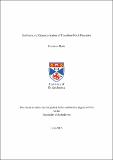Files in this item
Synthesis and characterisation of transition metal fluorides
Item metadata
| dc.contributor.advisor | Lightfoot, Philip | |
| dc.contributor.author | Black, Cameron | |
| dc.coverage.spatial | v, 180 p. | en_US |
| dc.date.accessioned | 2016-10-12T11:57:59Z | |
| dc.date.available | 2016-10-12T11:57:59Z | |
| dc.date.issued | 2015-11 | |
| dc.identifier.uri | https://hdl.handle.net/10023/9652 | |
| dc.description.abstract | This thesis reports exploratory studies on the synthesis of new vanadium and copper-containing compounds, with a particular emphasis on preparing new magnetically-active materials with S = ½ spin configurations. Eighteen crystal structures are reported, sixteen of which represent new compounds. These materials were studied for magnetic behaviour where appropriate. The sixteen vanadium-containing compounds were prepared using either the hydrothermal, Solvothermal or ionothermal synthesis methods at temperatures ranging from 60 °C to 200 °C. Inorganic cations and organic moieties were used as templating agents to direct the structures, often targeting potentially frustrated lattices based on triangular motifs by using ‘triangular’ templating molecules such as guanidine. Solvent choices, as well as reactant ratios were all varied in order to produce the new oxide, fluoride and oxyfluoride compounds of vanadium. Three families of vanadium compounds were prepared from these methods; a family of 1D vanadium (IV) oxyfluoride ladder compounds of general formula AVOF₃ (A=K⁺, Rb⁺, Cs⁺ or NH₄⁺), and a family of 1D vanadium fluoride chain compounds of general formula A₂VF₅ (A=K⁺ or NH₄⁺). The third family is comprised of three vanadium-containing compounds of varying dimensionality that share guanidine as the common organic moiety. Several miscellaneous compounds of vanadium such as clusters and a new V (IV) layer were synthesized, and are reported. The two copper compounds containing compounds, analogous to the pseudo-kagome compound, Cu₃Bi(SeO₃)₂O₂Br, were prepared via solid-state techniques. A detailed neutron diffraction study was carried out on the two compounds to measure the evolution of the magnetic properties from room temperature down to 2.5 K. Representational analysis was utilised in order to provide a detailed magnetic model of the compounds. | en_US |
| dc.language.iso | en | en_US |
| dc.publisher | University of St Andrews | |
| dc.subject.lcc | QD181.F1B6 | |
| dc.subject.lcsh | Fluorides--Synthesis | en_US |
| dc.subject.lcsh | Fluorides--Analysis | en_US |
| dc.subject.lcsh | Transition metal compounds | en_US |
| dc.title | Synthesis and characterisation of transition metal fluorides | en_US |
| dc.type | Thesis | en_US |
| dc.type.qualificationlevel | Doctoral | en_US |
| dc.type.qualificationname | PhD Doctor of Philosophy | en_US |
| dc.publisher.institution | The University of St Andrews | en_US |
This item appears in the following Collection(s)
Items in the St Andrews Research Repository are protected by copyright, with all rights reserved, unless otherwise indicated.

